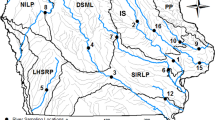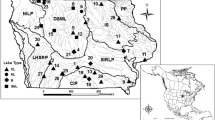Abstract
Mercury levels in fish have been demonstrated to increase after impoundment with augmented levels of mercury predicted to decline as the reservoir ages. Previous research in Newfoundland predicted return rates in the order of 10 to 12 years for landlocked Atlantic salmon or ouananiche (Salmo salar) and 7 years for brook trout (Salvelinus fontinalis). In order to test the validity of these predictions on a broader spatial and temporal scale, and develop more generally predictive ‘models’, mercury levels in three fish species were studied in 16 older Newfoundland hydroelectric reservoirs of various age (32 to 95 years) and area flooded (21 to 13,000 ha).
Mercury concentrations were standardized to fish length and correlated with physical, chemical, and biological characteristics of the sampling sites. Standard length mercury levels ranged from 0.23 to 0.86 ppm in ouananiche, 0.13 to 0.59 ppm in brook trout, and 0.22 to 0.72 in arctic charr (Salvelinus alpinus). Fish in excess of the Canadian Safety Limit (0.5 ppm) were collected from 14 of 16 sites for ouananiche, 8 of 17 sites for brook trout, and 3 of 7 sites for arctic charr, including control lakes. Standard length fish mercury levels were correlated with reservoir age and (log10) area flooded for ouananiche and with pH for arctic charr. A multiple regression model was developed relating standard length mercury in ouananiche with reservoir age and log10 of the flooded area. There were no apparent relationship between reservoir characteristics and brook trout mercury concentrations. Based on this analysis, it is not possible, at present, to develop generally predictive models for all species found in Newfoundland impoundments.
Similar content being viewed by others
References
Abernathy AR & Cumbie PM (1977) Mercury accumulation by largemouth bass (Micropterus salmoides) in recently impounded reservoirs. Bull. Environm. Cont. Tox. 17: 595–602
Akagi H, Mortimer DC & Miller DR (1979) Mercury methylation and partitioning in the aquatic environment. Environm. Cont. Tox. 17: 595–602
Anderson MR, Scruton DA, Williams UP & Payne JF (1995) Mercury in fish in the Smallwood Reservoir, Labrador, twenty-one years after impoundment. Water Air Soil Poll. 80: 927–930
Anderson, MR & Scruton DA (1997) Return time for mercury in the Smallwood Reservoir, Labrador; Trophic level versus species specific response. In: Pierce RC & Williams D (Eds) Book of Abstracts: Department of Fisheries and Oceans, Green Plan Toxic Chemicals Program, Wrap-up Conference (p 22). Government Conference Centre, Ottawa, Ontario, January 28–31. Can. Tech. Rep. Fish. Aquat. Sci. 2163: xiv + 93 pp
Bishop K, Lee Y-H, Pettersson C & Allard B (1995) Terrestrial sources of methyl mercury in surface waters: The importance of the riparian zone on the Svartberget catchment. Water Air Soil Poll. 80: 435–444
Bodaly RA, Hecky RE & Fudge RJ (1984) Increases in fish mercury levels in lakes flooded by the Churchill River diversion, northern Manitoba. Can. J. Fish. Aq. Sci. 41: 682–691
Bodaly RA, St. Louis VL, Paterson MJ, Fudge RJP, Hall BD, Rosenberg DM & Rudd JWM (1997) Bioaccumulation of mercury in the aquatic food chain in newly flooded areas. In: Sigel A & Sigel H (Eds) Metal Ions in Biological Systems. Volume 34, Mercury and its Effects on Environment and Biology (pp 259–287). Marcel Dekker Inc., New York
Brouard D, Demers C, Lalumiere R, Schetange R & Verdun R (1990) Summary Report: Evolution of Fish Mercury Levels in fish of the La Grande Hydroelectric Complex, Quebec (1978–1989). Hydro Quebec, Montreal, PQ, 97 pp
Gilmour CC & Henry EA (1991) Mercury methylation in aquatic systems affected by acid deposition. Environm. Poll. 71: 131–169.
Grieb TM, Driscoll CT, Gloss SP, Schofield CL, Bowie GL & Porcella DB (1990) Factors affecting mercury accumulation in fish in the Upper Michigan Peninsula. Environm. Cont. Tox. 9: 919–930
Hecky RE, Bodaly RA, Ramsey DJ & Strange NE (1987) Mercury bioaccumulation in yellow perch in limno-corrals simulating the effects of reservoir creation. Can. Data Rep. Fisheries and Aquatic Sciences 628: 158 pp
Huckabee JW, Elwood JW & Hildebrand SG (1987) Accumulation of mercury in freshwater biota. In: Nriagu JO (Ed) The Biogeochemistry of Mercury in the Environment (pp 277–302). Elsevier, Amsterdam, the Netherlands, 696 pp
Jackson TA (1988) The mercury problem in recently formed reservoirs in northern Manitoba (Canada): Effects of impoundment and other factors on the production of methyl mercury by microorganisms in sediments. Can. J. Fish. Aq. Sci. 45: 1744–1757
Johnston TA, Bodaly RA & Mathias JA (1991) Predicting fish mercury levels form physical characteristics of boreal reservoirs. Can. J. Fish. Aq. Sci. 48: 1468–1475
Jones ML, Cunnningham GL, Marmorek DR, Stokes PM, Wren CD & DeGraff D (1986) Mercury release in hydroelectric reservoirs. Canadian Electrical Association, Montreal, PQ, Report CEA 185 G 399, 156 pp + appendices
McMurty MJ, Wales DL, Scheider WA, Beggs GL & Dimond PE (1989) Relationship of mercury concentrations in lake trout (Salvelinus namaycush) and smallmouth bass (Micropterus dolomieui) to the physical and chemical characteristics of Ontario lakes. Can. J. Fish. Aq. Sci. 46(2): 426–434
Menzel DW & Corwin N (1965) The Measurement of Total Phosphorous in Seawater Based on the Liberation of Organically Bound Fractions by Persulfate Oxidation. Contribution No. 1528 of the Woods Hole Oceanographic Institution, Woods Hole, Massachusetts
Montgomery S, Mucci A, Lucotte M & Pichet P (1995) Total dissolved mercury in the water column of several natural and artificial systems of Northern Quebec (Canada). Can. J. Fish. Aq. Sci. 52: 2483–2492
Morrison K & Thérien N (1991) Influence of Environmental Factors on Mercury Release in Hydroelectric Reservoirs. Canadian Electrical Association, Montréal, Quebec, 122 pp
Murphy J & Riley JP (1962) A modified single solution method for the determination of phosphate in natural waters. Anal. Chim. Acta. 27: 31–36
Ramal PS, Rudd JWM, Furutani A & Xun L (1985) The effect of pH on methyl mercury production and decomposition in lake sediments. Can. J. Fish. Aq. Sci. 42: 685–692
Rudd JWM, Turner MA, Furutani A, Swick A & Townsend B (1983) The English-Wabagoon River system. I. A synthesis of recent research with a view towards mercury amelioration. Can. J. Fish. Aq. Sci. 40: 2206–2217
Scruton DA, Petticrew EL, LeDrew LJ, Anderson MR, Williams UP, Bennett BA & Hill EL (1994) Methyl mercury levels in fish tissue from three reservoir systems in Insular Newfoundland, Canada. In: Watras CJ & Huckabee JW (Eds) Mercury Pollution: Integration and Synthesis (pp 441–445). CRC Press, Inc., Boca Raton, Florida
Scruton, DA, Anderson, MR, French KJ & LeDrew LJ (1997) Spatial and temporal aspects of mercury evolution in fish from hydroelectric reservoirs in Newfoundland, Canada. In: Pierce RC & Williams D (Eds) Book of Abstracts: Department of Fisheries and Oceans, Green Plan Toxic Chemicals Program, Wrap-up Conference (p 72). Government Conference Centre, Ottawa, Ontario, January 28–31. Can. Tech. Rep. Fish. Aquat. Sci. 2163: xiv + 93 pp
Slemr F & Langer E (1995) Anthropogenic influences on the global mercury cycle: A model based analysis. Water Air Soil Poll. 80: 265–272
Stainton MP, Capel MJ & Armstrong FAJ (1977) The Chemical Analysis of Fresh Water, 2nd edn. Fish. Mar. Serv. Misc. Spec. Public. 25: 166 pp
Strickland JDH & Parsons TR (1972) A Practical Handbook of Seawater Analysis, 2nd edn. Bull. Fish. Res. Board Can. 167: 203 pp
Verdon R, Brouard D, Demers C, Lalumiere R, Laperle M & Schetagne R (1991) Mercury evolution (1978–1988) in fishes of the La Grande hydroelectric complex, Quebec, Canada. Water Air Soil Poll. 56: 405–417
Verta M (1990) Mercury in Finnish forest lakes and reservoirs: Anthropogenic contribution to the load and accumulation in fish. Publications of the Water and Environment Research Institute. National Board of Water and Environment, Finland 6: 33 pp
Verta M, Rekolainen S & Kinnunen K (1986) Causes of increased mercury levels in Finnish reservoirs. Publications of the Water Research Institute, National Board of Waters, Finland 65: 44–58
Wiener JG, Martini RE, Sheffy TB & Glass GE (1990) Factors influencing mercury concentrations in walleye in Northern Wisconsin Lakes. Trans. Am. Fish. Soc. 119: 862–870
Wren CD & MacCrimmon HR (1983) Mercury levels in the sunfish, Lepomis gibbosus, relative to pH and other environmental variables of Precambrian Shield lakes. Can. J. Fish. Aq. Sci. 40: 1737–1744
Rights and permissions
About this article
Cite this article
French, K., Anderson, M., Scruton, D. et al. Fish mercury levels in relation to characteristics of hydroelectric reservoirs in Newfoundland, Canada. Biogeochemistry 40, 217–233 (1998). https://doi.org/10.1023/A:1005975714493
Issue Date:
DOI: https://doi.org/10.1023/A:1005975714493




